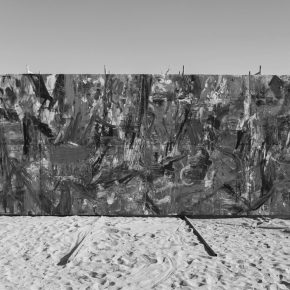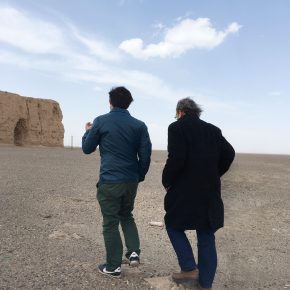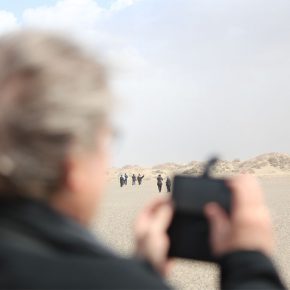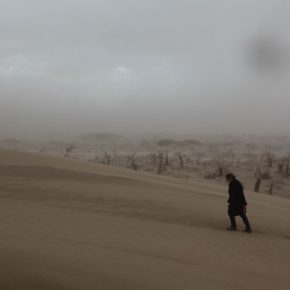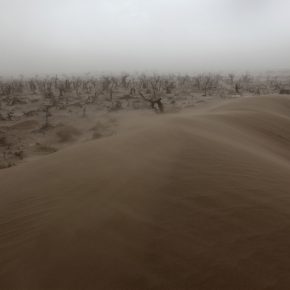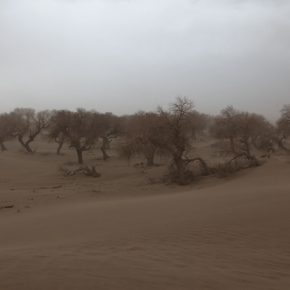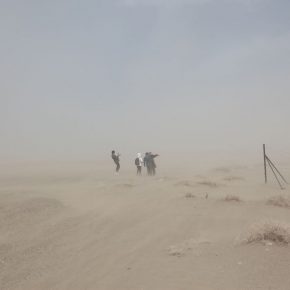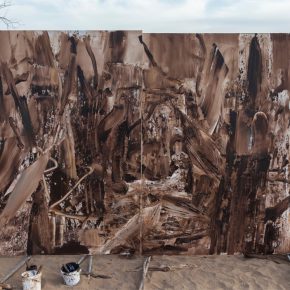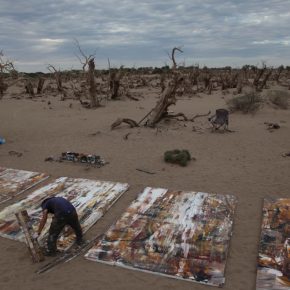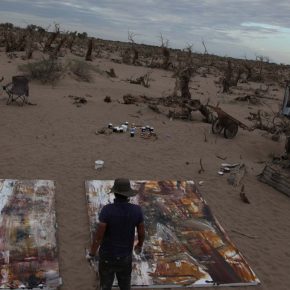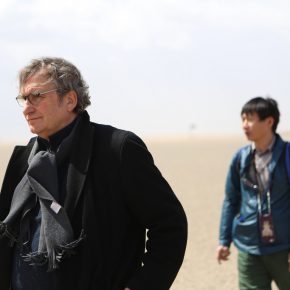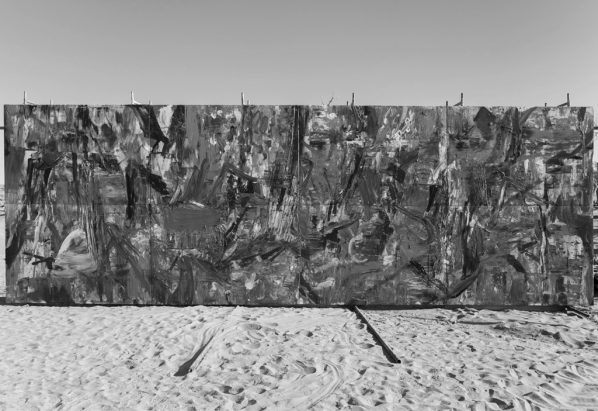
Interview Date: April 14, 2017
Interview Venue: LSY Studio in Houshayu, Beijing
Interview Participants: Mr. Olivier Kaeppelin (curator), Liu Shangying (artist), Ms. Deng Sanhong (interpreter)
Question 1: How are you related to landscape as a painter?
LSY: This fully open field always inspires me and gives me strength. I felt a strong bond with nature there. It was indeed utter helplessness the first time I got to Ali in Tibet in 2011. Standing before the wide expanse of wilderness, I found my experience in traditional painting became totally insignificant and everything was invalidated. It was right there and then I realized that I needed to return to painting and start afresh with nature. The primordial landscape, in particular, like an intersecting surface of the natural chaos of the universe, captivated me with its enigmatic beauty and strength. It involved no instruction, introduction, or functionality --- one had to rely on impulse to make judgment and observe. Here the natural landscape was merely a vehicle, and what I needed was to be in the field physically. Everything, near and far, high and low, had to be digested and experienced over a long time. More importantly, I had to face everything by myself. Rather than an act on impulse or mere emotional expression, painting was then like farming or grazing, an activity that took man back to nature for the most primeval bond and communication. I therefore felt the empathy with the Chinese painters in ancient times who wandered in nature. They were not focused on the landscape itself but tried to immerse themselves into the wide and abstruse nature.
Question 2: Why do you choose painting instead of something else to express this spiritual experience?
LSY: As a process, painting is direct, giving vent to creative imagination and experience, in which each stroke is born of the mind without any agent. Also painting, unadorned and simple, represents the oldest way for people to make sense of the word. It builds a world that is both magical and real. It has been there for thousands of years. The paintings on the rocks, having survived throughout the ages, remain as vivid as the the wild flowers by the rock, or all the living things we see today. Luckily I was born into a family with art tradition, and my parents are both professors at art academies. When I was seven or eight years old, in 1982 or 1983, I remember, they took me to an exhibition from the US. Quite young and short, I could only reach an adult’s waist. Through the space in the crowded visitors, I happened to catch a glimpse of a portrait of a lady, slender and with tilted head. I was greatly impressed --- the painter later turned out to be Modigliani. When I was ten years old, my father brought from Dunhuang a number of facsimiles of murals. Excited by the the flying Apsaras, for a long time I was picturing in mind many people flying in the sky. In a way Modigliani’s portrait and my father’s mural copies helped to form my initial understanding of painting in my childhood: it was enigmatic beauty. There has been a voice from my subconscious world ever since that painting, unlike photography, is to stir inexhaustible imagination. After I majored in art later, painting gradually revealed to me its unique way of expression, a process that dealt with growth from nothing to being. By the way, painting was also the best solitude in real sense of the word, as it gives me a chance to communicate with myself. Each and every surprise and puzzle is a adventure because my thinking will change with the subtle changes in the painting, which can in turn grow with the activated thinking. The brush is roaming, stroking the canvas, causing everything to move and rely on one another, not knowing when another surprise will come. It’s a strange and magical feeling we cannot find in everyday life.
Question 3: Just now you talked about your direct feeling, like the one you got directly from the interaction between the brush and the canvas. When I look at your painting, I discover a very important physical dimension. Your project in Inner Mongolia is a mixture of physical involvement and landscape painting. What’s your opinion about performance and painting?
LSY: Well, painting itself is performance, or painting, as a process, is performance. I should say, however, there is no definitive range or meaning of such performance. Painting, different from photography that is done through pushing the shutter, has its own dimension of time. Painting is always on the move, closely connected with the painter the painter’s consciousness. The finished painting is just the representation of a certain point in the process in which the painter keeps exploring until the moment of the performance. What motivates me in this performance is my bond with nature, which also extends my painting as a process. Only when I am there to communicate with nature vis-à-vis, can painting be activated. Our communication leads to a fully open, real, lively atmosphere that overwhelms me. In the desert in Mongolia, the wind blew sand onto the canvas, taking part in the painting process as a powerful force from nature. Whatever I did then, painting or something else, there was a kind of violence that tried to dominate everything. When we went there yesterday, we were caught in the wind, rain, sand storm and hailstone altogether. Wasn’t it tough enough? But it just participated following its tempo and its way and caring little about us. Then my sensory system shifted from my regular state of painting to a kind of game against nature, and my body unconsciously moved in a more expansive way. Everything changed at quite a speed during a day, and my perception was both fragmentary and integral. I could not afford to stop to hesitate and had to follow the tempo of the wind and the sand: I was either to beat the sand and the wind or to get beaten. In this special game, my concentration was greatly improved as a result of the violence of nature, and my movement, including body movement, was more directed by instinct, leaving any design or hesitation smashed. The connection with nature was greatly weakened, and the delicate emotional tie based on the painting was ready to collapse at any moment. On the verge of control and loss of control, I realized that my painting and I were just part of nature. I hurt my arm while doing this painting, the largest of all --- I had overexerted myself unaware. When fully absorbed, one is oblivious of his surroundings and does not have anything on his or her mind to overcome. All my movements are naturally formed into a harmonious unity, and each and every experience is exhilarating and almost impeccable, totally different from working in the studio.
Question 4: If we speak about the history of art, please make a comparison between your painting and the so-called “action painting” (those who paint with art & performance, action & painting), like Jackson Pollock and Kazuo Shiraga from the Japanese Gutai group”.
LSY: I was very much impressed by Pollock’s paintings the first time I saw them in the Metropolitan Museum of Art in 2002. The complexity and density were really the appeal. As to Kazuo Shiraga, I haven’t seen his original, only screen shots, but they are impressive enough for his gestures that gave a new dimension to pictorial expression. As to similarities and differences, if there are, I think we both try to perceive with no other medium than painting in a more immediate or direct manner on one hand, and we belong to different ages and have different experience and cultural background on the other. Attaching great importance to the awareness of subjective consciousness, they are ready to highlight the primeval force by releasing into the works the primal aspect in their physical being. Pollock was like a performer dancing with time in a two-dimensional world, while Kazuo Shiraga came onto the scene like a warrior displaying speed and strength in a flash, but I’m more like an ancient Chinese who has something specific in his mind: nature, a fully open field. I focus more on my interaction or communication with nature, which is the prelude to my subjective consciousness. It is not only about how I watch and experience but also about how nature participates in my painting. I drove all the way from Beijing there in the hope of getting a sense of the changes in land as I moved from a big city to a fairly primordial place. All was included in my approach and the painting process, and the painting, the final product of this process, was only the last step.
Question 5: To show the complexity of the landscape, I’d like to know if there are any foreign or Chinese artists that influence you a lot in painting. You’ve mentioned Modigliani and Giotto. How about Chinese painters?
LSY: Of course, many Chinese painters have inspired me. Whatever time period, style or place, the East or the West, it belongs to, great art always tries to establish a passage between spirit and technique and a unique world outlook. Greet art must be simple and unsophisticated. It has something divine with a kind of complicity of humanity and life. Both Western artists, and Chinese artists, like Giotto, Rembrant, Vermeer, Goya, Turner, Delacroix, Van Gogh, Cezanne, Matisse, Pollock, and Chinese artists, like Huaisu (calligrapher in Tang Dynasty), Fan Kuan and Guo Xi (painters in Song Dynasty), Huang Gongwang (Painter in Yuan Dynasty), Xu Wei (painter in Ming Dynasty), Gong Xian, Zhu Da, and Shi Tao (artists in Qing Dynasty), all have influenced me. They are still my models. It is very important to review art history and identify similarities in differences and vice versa. I agree with Qi Baishi, a great master in modern China, that painting is something between similarity and dissimilarity. To me, neither the subconscious world nor the objective world as I see with my eyes is reliable. Landscape ink paintings in Song ans Yuan dynasties appeared to be renderings of the landscape, but they were actually about our knowledge and understanding, i.e., our mind. The same is true of some religious paintings in the West. Art, so I believe, should be the embodiment of our inquisitiveness about the world, and it is future-oriented. What I learn from Chinese traditional art is the ultimate attitude with which we view and experience the world, whereas Western art teaches me how to perceive this world distinctively, i.e., a specific, elaborate methodology.
Question 6: Talking about struggle, violence and the relation with nature, you are exhausted when fighting the physical dimension of nature. I also see from your painting the forest of sands, shape, colors. The first impression the landscape gave is that it is the victim of death (sand, dead tree) and it is abandoned. Does your painting involve the relationship with death?
LSY: My paintings touch on life and death, but they are not the only clue. I’ve never made a point of elaborating on the struggle with death because what I see there is a unique field left or set aside by nature, and I just can’t avoid it. In the meanwhile, however, I got a strong feeling that I was transported back to the past. It’s a very complicated feeling. These populus diversifolias, it is said, died over a hundred years ago. They look shockingly deformed because they have to save themselves by preventing water from evaporating in such aridity. What is incredible is, however, long exposure to sand and wind surprisingly lends life to the distorted forms, so these trees are like fragmented illusions of time that, after surviving the test of ages, plunge into nature. They intertwine each other as if their dance of life is suddenly freeze-framed, therefore acquiring eternity. They grow again in nature in another form. In the desert where they used to be, they admire the sunrise and the sunset and sing in various ways to the passing wind in company with the insects in the tree holes, the camels and birds. After staying with them for a while, I found there was also a kind of life in that place besides aridity and sand. I did not deliberately talk about life or death in my paintings, as everything was there, allowing for no judgment or discussion. I was only experiencing, in a unhurried way, if I can. I’ve been to the same place for three consecutive years, so within 20 km2 in the place I painted I knew well where these trees are and what they look like. I did experience some incredible movements. My tent has been picked up twice by the wind, and it was the branches that caught it, and when the wind overthrew my painting, it was the trunks that hold it , but it was their hard branches scattered in the desert that punctured my tyres. These episodes are valuable to me because these experience was exclusive to ordinary tourists. People may say my works are about life and death, but I believe there are a lot more complicated and magical things in nature that are both eternal and fleeting. What a rich world! They are unified into an organic whole as a universe. Though I could feel only part of this universe, it is as infinite as the universe itself. It is beyond my words, but I know it’s beyond me to interpret something by means of painting --- painting can help me to perceive it in a more attentive way.
Question 7: Do you think painting is more enduring than nature? You painting has given new life to the desert. In this room tonight, I have the feeling that your painting is more alive than nature.
LSY: Actually I don’t think my painting is more enduring or alive than nature. Here I can only say that these paintings are from my point of view and based on my own experience. It’s impossible to put in my works everything about the place, nor can I go beyond nature. But I do wish to go beyond myself, looking at myself and asking myself questions in nature through art. It is a very concrete and honest process, really fulfilling. The strength of art lies more on the spiritual level that was born of our long experience and fully charged emotions. More essentially, the muscle of art can reveal something about the future. In this sense, extraordinary art throughout history really go further than nature, we admit, but nature is great for the fact that it is always there, never to be changed. It beckons artists one after another to devote to art, so nature goes further than art. Form another perspective, nature and art do not differ because they both talk about the eternity of life. The life in nature is chaotic and primeval , while in art we find life that is created and given by external forces, both carrying mysteries and sacredness that are hidden under some objective phenomenon.
Question 8: What’s your understanding of “the nature of nature” by a Germany poet, meaning the nature of nature is deeper than nature itself. Can your paintings catch the heart of nature? Do you think painting is nature?
LSY: I believe, to some extent, painting is nature because growing is its natural quality. In nature everything grows in its own way. When flowers bloom to decorate the mountain, it is mere a beautiful moment, and no one cares or takes notice of what these flowers have experienced. It is the same with painting. It relies on the sun, air and water to grow, but it has to experience unpredictable changes, and sometimes it is even a cruel process. This kind of painting is worthy of its name. In the meanwhile I also believe that nature involves art, depending on our perspectives and spiritual reality. In a film, I remember, Beethoven told his students not to focus too much on the musical score and suggested that they immerse themselves in nature listening to the wind and the bird --- real music. I don’t think nature is greater than art or vice versa because they are just equal. Painting is a vehicle for me to approach nature and communicate or stay with it, which experience brings me closer to life, so I can feel its pulse and reach my soul. In painting, nature is not a medium for human emotion; it is instead an active being, a rich, complex and indeterminate entity, as hard to generalize as humanity, so I can only capture what I think is the core of nature, not the core in common sense.
Question 9: You are fascinated by E’Jina. What makes you lower your head and focus on the earth instead of looking up into the sky? Are there any other reasons for your choice of Inner Mongolia?
LSY: I happened to see some photos my parents took in E’jina when they were just back. This place by the ancient Silk Road looked amazing, different from Tibet, so I decided to take a look. I was indeed shocked by the the dead populus diversifolias in the E’jina Desert in the beginning. There was a sandstorm the day I arrived, I remember, and everything was wrapped in the sand or its shadow. On the open Gobi by the woods lay in isolation ruins of an ancient city. There was nothing green in sight in this weird world. I immediately decided to do my paintings there. However, I didn’t find where to start until I was fully settled. I was initially attracted to the atmosphere, but little by little I found treasures were revealing to me layer by layer. In Tibet, I looked into the distance and looked up into the sky. Elevated high, Tibet gave me the feeling that I was standing in the sky. The penetrating light and inexhaustible changes directed my eyes to the sky. Tibet is more like a pristine and beautiful girl. The desert in E’jina is a totally different picture, more like a man and his battle field. There I often had to lower my head and got the sand out of my shoes. This action was an invisible clue the desert gave me because when I look down, beetles, small lizards, desert mushrooms came into my sight. I didn’t include them in my paintings, but they did help to reveal more details about the populus diversifolias. The big trees standing erect there were impressive, and even more so were the branches or fragments of the tress that lay on the sand or were buried in it. So close to the land surface, these fragments felt the full impact of the wind and the sand, for they have very peculiar forms and grain. The sand on the ground, when tossed in the wind, became alive, waving and stroking the populus diversifolias. Then little by little, I got my own vantage point and perspective, thus focusing my attention on the details of these trees that were in my proximity and reached toward the ground. It was an irresistible urge to anatomize these forms of life.
Courtesy of the artist.


